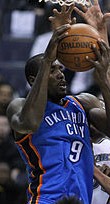Let’s look at some of those guys and their second-half numbers. I’ll use per-game averages here rather than per-minute.
Ersan Ilyasova: Ilyasova’s standing as the #6 player overall shows how effective he was over the second half, averaging 16 points, 9 rebounds, 1.1 threes and 1.5 assists in 30.5 minutes per game, shooting 55% from the field and 80% from the line. His worst category, assists (where he was -0.7 standard deviations below the average for the group) is one of the “best-worst” of any player, with only Dorell Wright, Carmelo Anthony and Josh Smith beating him among the top 40. That 55% on field goals and the rebounding are his best categories.
 Serge Ibaka: Ibaka’s standing as the #4 in per-minute FP rests almost entirely on his shotblocking game, the 4.1 per game in just 26.9 minutes meaning that he was 6.64 standard deviations above the group average in shotblocking. Ibaka can help you to head-to-head wins in blocked shots all on his lonesome. His overall averages (10 points, 7.5 rebounds, 55% FG) are helpful enough and he doesn’t turn the ball over. Just as a Dwight Howard’s free throw weakness doesn’t really peg back all his other strengths, Ibaka’s blocked shots strength doesn’t really supersede all his other weaknesses, but it gives him a lot of value.
Serge Ibaka: Ibaka’s standing as the #4 in per-minute FP rests almost entirely on his shotblocking game, the 4.1 per game in just 26.9 minutes meaning that he was 6.64 standard deviations above the group average in shotblocking. Ibaka can help you to head-to-head wins in blocked shots all on his lonesome. His overall averages (10 points, 7.5 rebounds, 55% FG) are helpful enough and he doesn’t turn the ball over. Just as a Dwight Howard’s free throw weakness doesn’t really peg back all his other strengths, Ibaka’s blocked shots strength doesn’t really supersede all his other weaknesses, but it gives him a lot of value.
Danny Green: This one, and the next one, are genuine surprises and shows what an embarrassment of riches the Spurs are working from and how high-powered their offense is in particular. Green averaged 23.4 minutes per game over the second half but was hugely effctive when he played: although he posted a very weak assist total for a guard, he averaged 11 points, 3 rebounds and an eye-popping 1.9 threes, finishing second to Randy Foye in threes per minute over the second half of the season. He was also a turnover booster at both ends, with a good mark in steals and a very good mark in turnovers.
Kawhi Leonard: Leonard also had an excellent second half on a per-minute basis, again probably helped by only having to play 24 minutes a game (and possibly, like Green, being helped by Popovich resting his star players against weaker teams). Leonard’s best feature is his versatility (especially his steals) and his shooting, thanks to ability as well as the great spacing that the Spurs have. (He made 53% on field goals and 87% on free throws in the second half.) He was even better at avoiding turnovers than Green; of the top 40 only Al Jefferson coughed the ball up less.
Leonard’s second-half averages of 8.7 points and 5.3 rebounds don’t look like anything special, despite his ability to fill the stat sheet with hustle plays. The per-minute stats tell a different story, of a player who could become a fantasy star if he can get more minutes while keeping his productivity.
Elton Brand: We’ll end with a couple of guys who are oldies but goodies. I could not believe that Elton Brand showed up as the 13th most-effective fantasy player per minute by this stat, but it shows how much his 30 minutes per game benefited the Sixers (and benefited his owners). As Brand gets older, as with many players, he has become more efficient and more thrifty—more conservative, if you will—and this benefits you in fantasy because he provides much stronger cross-category support. 11.9 points, 7.6 rebounds and 1.8 blocks aren’t going to make your tongue loll out, but if Brand is relied on heavily early in the season he might put up some big numbers.
Kevin Garnett: What goes for Brand goes doubly for KG; his standing at #8 overall is both a surprise and a testament to his ferocious play when he was on the court. KG is strong everywhere; outside threes he was not just positive in each category but strongly positive (50% on field goals, 85% FT, 17 points, 3.3 assists, 8.5 rebounds and 1.1 steals). It’s uncertain how much time KG will be getting but if you wanted to take a risk on his being needed, you’ll get a big boost in fantasy value across all categories.
This kind of measure, looking at second-half production, is not something that will be the right way to approach an entire draft. But it can identify a few players that are worth a target, especially from a risk point of view. You can employ measures like FP in other contexts during the season as well, and calculate stuff like this yourself. I’ll go over spreadsheet maintenance in a future column.
One final thought. This measure shows the degree to which the top three fantasy studs loom above every other player. Paul, Durant and James play huge minutes and yet are 1-2-3 in per-minute production, while other stars rank much lower.
Thanks to Klearchos Kapoutsis for the photo of Ersan Ilyasova
Great stuff. Really enjoyed it.
Is there somewhere I can grab the stats from the last 20 games from last season? 10 doesn’t seem like it’s enough to gauge the “2nd half,” as the last 10 games can be skewed by teams resting players for the playoffs and other late-season issues…